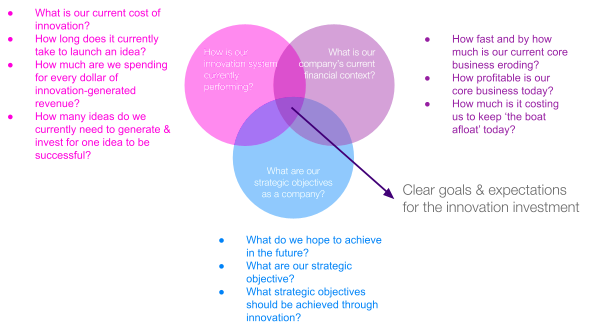
The Three Things You Need to Set Goals For Your Innovation Investment
- Posted by Dan Toma
- On 13/06/2022
A lot has been invested in the name of innovation over the past years – even before the pandemic. The pandemic however, highlighted once more the importance of innovation and the importance of an established innovation system & culture able to constantly bring to life successful new business models. Companies that haven’t necessarily considered innovation as a growth imperative before the pandemic woke up to the reality that innovation is no longer a nice to have but more of an insurance policy in the face of changing times.
Unfortunately however, in many cases the level of investment in innovation isn’t matching the outcomes from those investments. Take for example the Pharma industry. In the 2021 ‘Top 50 Most Innovative Companies in the World’ there were 3 names: Johnson & Johnson, Novartis and Bayer. But at the same time on the 2021 ‘Top 50 Biggest R&D Spenders’ there were more than a dozen companies from that industry. Putting the two tops side by side makes it clear that in some cases the investment is disproportionate to the return.
Getting return on the innovation investment depends on a plenitude of factors, from internal capabilities to external market conditions. But probably one of the first things (and most important) corporate leaders need to do to give the innovation investment a chance to succeed, is to set clear goals for their innovation commitments.
Setting goals for innovation-led growth helps bring together the company’s core business and its various innovation vehicles. No longer will innovation be seen as a fancy expense, but a clear contributor to the company’s overall growth ambitions and strategy.
So how should you go about setting up goals for innovation investment?
Setting goals for innovation-led growth requires three main ‘ingredients’:
- the growth ambitions of the company as per its strategy (and in particular its innovation strategy) or agreed upon with the shareholders,
- the company’s financial context (past and present) and
- the company’s innovation system past performance.

1) The growth ambitions of the company as per its strategy (and in particular its innovation strategy) or agreed upon with the shareholders.
Every company needs to first agree on a strategy and have clear growth ambitions before deciding what’s the best way to achieve those ambitions. You can’t talk about goals for the innovation investment without having first clear strategic objectives to which innovation should contribute to. These goals can revolve around entering a certain market, capitalizing on a certain trend or even defending a certain market position.
Given a certain level of clarity around what the company wants to achieve, leaders will find it easier to understand how big should their commitments towards innovation be.
In essence, leaders need to ask themselves where does the company need to be in the future? The answer to this question will serve as the basis for the goals for the innovation investment. In the absence of clarity around where the company is heading, the investment in innovation is going to be just an exercise in investing in the latest tech.
2) The company’s financial context (past and present)
The company’s financial context can be viewed as the main input to the innovation investment goals. The financial context needs to consider the current state the company is in but also its historical financial performance. For innovation investment goals setting there needs to be clarity around how fast is the ‘core business’ fading, how much is being spent on just ‘keeping the boat afloat’ and what’s the current profitability of the core.
These inputs will show what innovation needs to contribute to the top line growth, for the company to have, at the very least, the same level of financial performance in the coming years as it has today.
3) The company’s innovation system’s past performance.
One can’t talk about realistic goals in the absence of a clear benchmark. Understanding the company’s innovation system’s past performance, will help leaders understand what’s realistic to expect in terms of returns, given a certain financial commitment towards innovation they’d like to make.
Or the other way around, will help leaders understand if commitments they were planning on making towards innovation are enough for what they were hoping to get out, given the past performance of the innovation system.
Understanding the past performance of a company’s innovation system means getting clarity around some Innovation Accounting indicators. Such as:
- the time it takes the company to bring an idea to market, named in the Innovation Accounting book Time to Sustain;
- the number of ideas that were generated for one idea to be successful in the market also known as Average Funnel Conversion Rate;
- how much has the company been spending on average to have a successful new idea in the market – the Cost of Innovation;
- and lastly how much was spent in the past on innovation for every dollar of new revenue generated today by those new ideas – called in the Innovation Accounting book Efficiency of Innovation Investment.
Clarity around these Innovation Accounting indicators will help the company understand, on the one hand, if there are any investments required for improving the innovation system, and on the other hand help the company manage expectations in case they commit a certain amount to innovation.
Starting from these three inputs, leaders can be more pragmatic (and deliberate) about how much they want to and need to invest in innovation-led growth. When companies aim to sustainably grow through innovation, the exercise of setting clear goals for the innovation investment is not just ‘a corner to be cut’ but an integral part of the effort.


